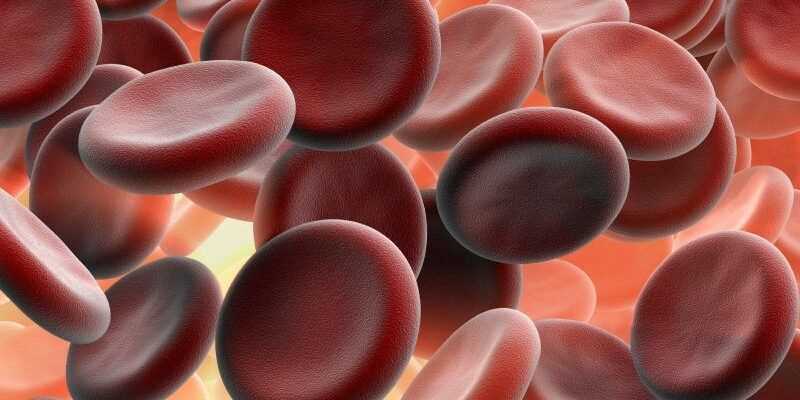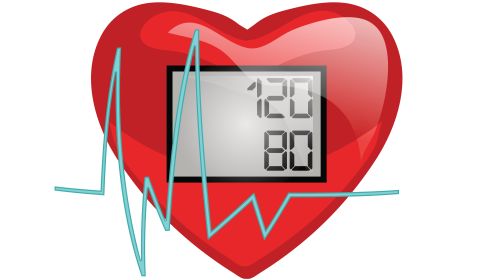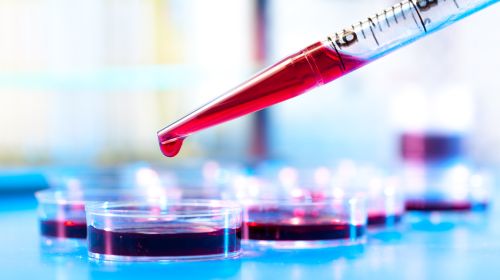Erythrocytes (red blood cells) regulate the transport of oxygen in the blood. Read here when the values in the blood are too high or too low and the possible causes of erytrocytes in the urine.
- The number of erythrocytes in the blood provides information about how well the organism is supplied with oxygen.
- © iStock.com/Orla
At a glance:
Task: What are erythrocytes?
The erythrocytes, like thrombocytes and leukocytes, belong to the blood cells. With the blood pigment hemoglobin, they transport oxygen from the lungs via the smallest blood vessels (capillaries) into the tissue. The number of erythrocytes in the blood provides information, among other things, on how well the body is supplied with oxygen.
A healthy erythrocyte is a disc-shaped, inwardly indented, nucleated cell. It consists of 90 percent of the red blood pigment hemoglobin. The erythrocytes are produced from stem cells in the bone marrow with the help of iron, folic acid and vitamin B12. This process is controlled by the hormone erythropoietin, also known as EPO.
After a lifespan of around 120 days, the red blood cells in the spleen are broken down again. The human bloodstream contains around 24 to 30 trillion erythrocytes, around two million of which are newly produced every second. Changes in the number of erythrocytes in the blood can indicate a wide variety of diseases and deficiencies.
When is the erythrocyte count determined?
The erythrocyte value is not only measured to diagnose anemia (anemia) or in the event of a possible polyglobulia (too many red blood cells). The number of red blood cells is one of the most commonly determined blood values. Deviations of the value from the norm provide information about the state of the oxygen supply to the organism. The number of erythrocytes (abbreviation Ery, English: RBC = red blood count) is therefore determined by default in the "small blood count".
How is the erythrocyte count determined?
The number of erythrocytes is measured in whole blood. To do this, the erythrocytes are first counted by machine. If there are abnormalities, a microscopic assessment of the blood is also carried out. The small blood count not only determines the number of erythrocytes, but also other properties such as the shape, volume and color of the blood cells and their hemoglobin content with the values MCH, MCHC and MCV.
The hematocrit value, which indicates the proportion of all solid blood components in the total blood volume, is closely related to the Erys. The erythrocytes make up over 95 percent of all blood cells, so that the erythrocyte count has a significant influence on the hematocrit value.
Normal erythrocyte count in men and women
The normal values for erythrocytes differ according to gender. The following levels of red blood cells are considered normal in healthy people:
In men, the Ery value is 4.3 (lower limit) to 5.7 (upper limit) million per microliter.
For women, erythrocyte values between 3.9 (lower limit) and 5.3 (upper limit) million per microliter are normal.
Causes of an excessively high erythrocyte count
If the number of red blood cells is increased, the oxygen level in the blood may be decreased. This is the case with a heart or lung disease. The erythrocyte count can also be increased in smokers and due to severe fluid loss. Kidney disease also causes the body to have too many red blood cells. In certain diseases, too many erythrocytes are produced in the bone marrow. The blood is then "thicker" and the risk of thrombosis increases.
The number of erythrocytes is also increased during physical training, competitive sports or when staying at high altitudes for a long time, because the body signals an increased need for oxygen, which should be covered by the increased production of red blood cells. Last but not least, EPO as a doping agent in sport increases the number of erythrocytes.
Causes of an erythrocyte count that is too low
Too low a number of red blood cells occurs in:
excessive fluid intake (thinning effect)
Deficiency in iron, folic acid and / or vitamin B12 (e.g. through a one-sided vegetarian diet)
large blood loss (internal or external bleeding, heavy menstruation, after surgery)
anemia
Bone marrow disease, such as leukemia or tumors
abnormally increased breakdown of red blood cells (hemolysis)
Erythrocytes in the urine
Blood in the urine is a common symptom of a bladder infection, urinary stones, or malignant changes in the genitourinary tract. However, the blood is not always visible to the naked eye. With the help of test strips, erythrocytes can be detected in the urine even in the smallest quantities.
Deviations in the number of erythrocytes from the norm can have very different causes. The value can vary seasonally, depending on the time of day and the testing laboratory. The doctor will therefore always use additional values to interpret the erythrocyte value and diagnose physical complaints.



